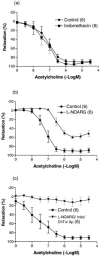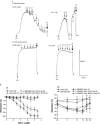Endothelium-derived hyperpolarizing factor and potassium use different mechanisms to induce relaxation of human subcutaneous resistance arteries
- PMID: 11454664
- PMCID: PMC1572851
- DOI: 10.1038/sj.bjp.0704143
Endothelium-derived hyperpolarizing factor and potassium use different mechanisms to induce relaxation of human subcutaneous resistance arteries
Abstract
This investigation examined the hypothesis that release of K(+) accounts for EDHF activity by comparing relaxant responses produced by ACh and KCl in human subcutaneous resistance arteries. Resistance arteries (internal diameter 244+/-12 microm, n=48) from human subcutaneous fat biopsies were suspended in a wire myograph. Cumulative concentration-response curves were obtained for ACh (10(-9) - 3x10(-5) M) and KCl (2.5 - 25 mM) following contraction with noradrenaline (NA; 0.1 - 3 microM). ACh (E(max) 99.07+/-9.61%; -LogIC(50) 7.03+/-0.22; n=9) and KCl (E(max) 74.14+/-5.61%; -LogIC(50) 2.12+/-0.07; n=10)-induced relaxations were attenuated (P<0.0001) by removal of the endothelium (E(max) 8.21+/-5.39% and 11.56+/-8.49%, respectively; n=6 - 7). Indomethacin (10 microM) did not alter ACh-induced relaxation whereas L-NOARG (100 microM) reduced this response (E(max) 61.7+/-3.4%, P<0.0001; n=6). The combination of ChTx (50 nM) and apamin (30 nM) attenuated the L-NOARG-insensitive component of ACh-induced relaxation (E(max): 15.2+/-10.5%, P<0.002, n=6) although these arteries retained the ability to relax in response to 100 microM SIN-1 (E(max) 127.6+/-13.0%, n=3). Exposure to BaCl(2) (30 microM) and Ouabain (1 mM) did not attenuate the L-NOARG resistant component of ACh-mediated relaxation (E(max), 76.09+/-8.92, P=0.16; n=5). KCl-mediated relaxation was unaffected by L-NOARG+indomethacin (E(max); 68.1+/-5.6%, P=0.33; n=5) or the combination of L-NOARG/indomethacin/ChTx/apamin (E(max); 86.61+/-14.02%, P=0.35; n=6). In contrast, the combination of L-NOARG, indomethacin, ouabain and BaCl(2) abolished this response (E(max), 5.67+/-2.59%, P<0.0001, n=6). The characteristics of KCl-mediated relaxation differed from those of the nitric oxide/prostaglandin-independent component of the response to ACh, and were endothelium-dependent, indicating that K(+) does not act as an EDHF in human subcutaneous resistance arteries.
Figures


Similar articles
-
Contribution of K+ channels and ouabain-sensitive mechanisms to the endothelium-dependent relaxations of horse penile small arteries.Br J Pharmacol. 1998 Apr;123(8):1609-20. doi: 10.1038/sj.bjp.0701780. Br J Pharmacol. 1998. PMID: 9605568 Free PMC article.
-
Interactions between endothelium-derived relaxing factors in the rat hepatic artery: focus on regulation of EDHF.Br J Pharmacol. 1998 Jul;124(5):992-1000. doi: 10.1038/sj.bjp.0701893. Br J Pharmacol. 1998. PMID: 9692786 Free PMC article.
-
NO/PGI2-independent vasorelaxation and the cytochrome P450 pathway in rabbit carotid artery.Br J Pharmacol. 1997 Feb;120(4):695-701. doi: 10.1038/sj.bjp.0700945. Br J Pharmacol. 1997. PMID: 9051310 Free PMC article.
-
Evidence against potassium as an endothelium-derived hyperpolarizing factor in rat mesenteric small arteries.Br J Pharmacol. 2000 Feb;129(3):605-11. doi: 10.1038/sj.bjp.0703076. Br J Pharmacol. 2000. PMID: 10711361 Free PMC article.
-
Variability of geometry, hemodynamics and intimal response of human arteries.Monogr Atheroscler. 1990;15:109-16. Monogr Atheroscler. 1990. PMID: 2404191 Review. No abstract available.
Cited by
-
Enhanced endothelium derived hyperpolarising factor activity in resistance arteries from normal pressure glaucoma patients: implications for vascular function in the eye.Br J Ophthalmol. 2005 Feb;89(2):223-8. doi: 10.1136/bjo.2004.044446. Br J Ophthalmol. 2005. PMID: 15665357 Free PMC article.
-
Electrical coupling and release of K+ from endothelial cells co-mediate ACh-induced smooth muscle hyperpolarization in guinea-pig inner ear artery.J Physiol. 2005 Apr 15;564(Pt 2):475-87. doi: 10.1113/jphysiol.2004.080960. Epub 2005 Feb 24. J Physiol. 2005. PMID: 15731195 Free PMC article.
-
Endothelium-dependent smooth muscle hyperpolarization: do gap junctions provide a unifying hypothesis?Br J Pharmacol. 2004 Mar;141(6):881-903. doi: 10.1038/sj.bjp.0705698. Br J Pharmacol. 2004. PMID: 15028638 Free PMC article. Review.
-
Systemic vascular endothelial cell dysfunction in normal pressure glaucoma.Br J Ophthalmol. 2002 Feb;86(2):227-32. doi: 10.1136/bjo.86.2.227. Br J Ophthalmol. 2002. PMID: 11815352 Free PMC article.
-
The effect of nitric oxide synthase and cyclooxygenase inhibition on cutaneous microvascular reactivity.Eur J Appl Physiol. 2008 Aug;103(6):719-26. doi: 10.1007/s00421-008-0769-8. Epub 2008 May 31. Eur J Appl Physiol. 2008. PMID: 18516617
References
-
- AALKJAER C., HEAGERTY A.M., PETERSEN K.K., SWALES J.D., MULVANY M.J. Evidence for increased media thickness, increased neuronal amine uptake and depressed excitation-contraction coupling in isolated resistance vessels from essential hypertensives. Circ. Res. 1987;61:181–186. - PubMed
-
- ALBARWANI S., HEINERT G., TURNER J.L., KOZLOWSKI R.Z. Differential K+ channel distribution in smooth muscle cells isolated from the pulmonary artery tree of the rat. Biochem. Biophys. Res. Commun. 1995;208:183–189. - PubMed
-
- BRANDES R.P., BEHRA A., LEBHERZ C., BÖGER R.H., BODE-BÖGER S.M., PHIVTHONG-HGAM L., MÜGGE A. NG-nitro-L-arginine- and indomethacin-resistant endothelium-dependent relaxation in the rabbit renal artery: effect of hypercholesterolemia. Atherosclerosis. 1997;135:49–55. - PubMed
-
- BRAYDEN J.E. Membrane hyperpolarization is a mechanism of endothelium-dependent cerebral vasodilation. Am. J. Physiol. 1990;259:H668–H673. - PubMed
-
- BUCKLEY C., HADOKE P.W.F., HENRY E., O'BRIEN C.J. Altered balance of endothelium-derived relaxing factors in the acetylcholine-mediated relaxation of subcutaneous arteries isolated from patients with normal pressure glaucoma. Br. J. Pharmacol. 1999;128 Proc Suppl:P264.
Publication types
MeSH terms
Substances
LinkOut - more resources
Full Text Sources
Medical

